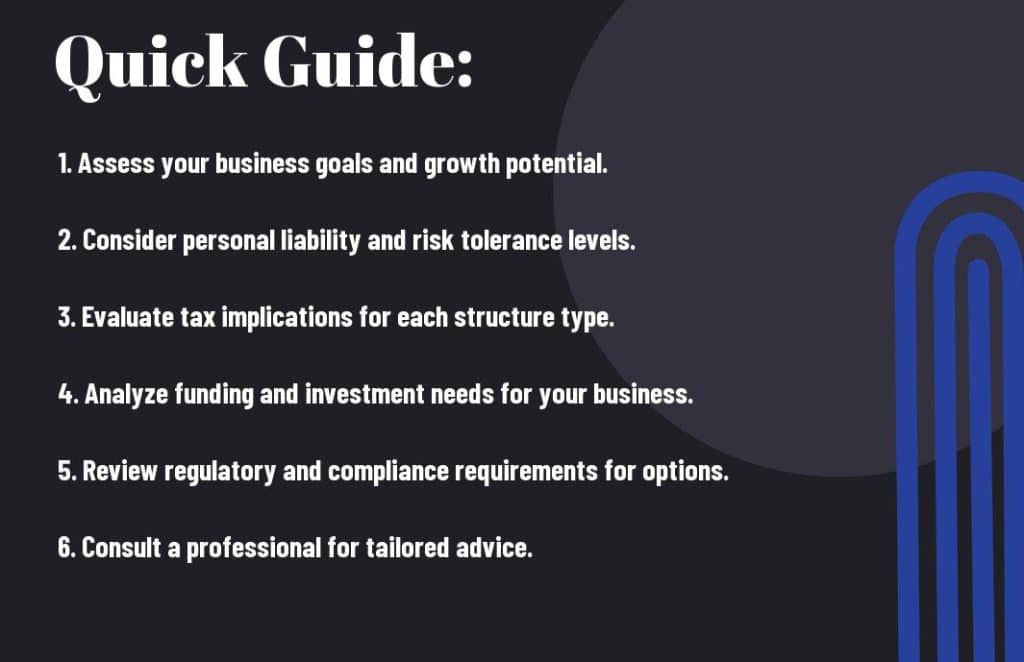What’s the best Australian business structure for me (sole trader, partnership, company, trust)?
Starting a business involves understanding the various Australian business structures available to you, such as sole trader, partnership, company, and trust. Each structure offers different benefits and challenges that can significantly impact your operations, liabilities, and tax obligations. By assessing your specific situation, including your business goals and financial needs, you can determine which option aligns best with your vision. This guide will explore each business structure, helping you make an informed choice for your entrepreneurial journey.

Key Takeaways:
- Business Structure Types: Understanding the different types such as sole trader, partnership, company, and trust is crucial for choosing the right fit for your business.
- Liability and Risk: Assess the level of personal liability you are willing to take on, as structures like companies offer more protection, while sole traders are at greater personal risk.
- Tax Implications: Evaluate the tax obligations associated with each structure, as some may offer advantages like lower tax rates or different distributions of profits.

Understanding Business Structures
To make informed decisions about your business, it’s vital to grasp various business structures available in Australia. Each structure presents distinct legal and tax obligations, impacting your operational flexibility and financial outcomes. By understanding these differences, you can choose the option that best aligns with your goals and risks.
Types of Business Structures
To help you navigate your options, here are the main types of business structures in Australia:
- Sole Trader
- Partnership
- Company
- Trust
Thou can effectively assess which structure suits your business ambitions.
| Business Structure | Key Characteristics |
|---|---|
| Sole Trader | Easy to set up, full control, unlimited liability |
| Partnership | Shared control and responsibility, flexible income distribution |
| Company | Separate legal entity, limited liability, more regulation |
| Trust | Assets held by a trustee for beneficiaries, tax benefits possible |
Key Features of Each Structure
Even within each business structure, there are notable features that play a fundamental role in your operations and responsibilities:
- Liability: degree of personal financial risk
- Ownership: who controls the business
- Taxation: how profits are taxed
- Compliance: legal obligations for operation
Recognizing these key features helps you align your decision with your business’s needs.
Plus, it’s beneficial to investigate deeper into each structure’s attributes to see how they apply to your situation:
- Costs: Initial setup and ongoing expenses
- Funding: Opportunities for raising capital
- Management: Degree of formalities in management and operations
- Succession: How ownership can transfer in future
Recognizing these aspects will aid you in selecting the best structure for your ongoing success.
Pros and Cons of Each Structure
One of the key aspects to consider when choosing a business structure is the balance between the advantages and drawbacks each type offers. Below is a concise overview to help you weigh your options:
| Business Structure | Pros | Cons |
| Sole Trader | Easy to set up, complete control | Unlimited liability, hard to raise funds |
| Partnership | Shared resources, simple management | Joint liability, potential for disputes |
| Company | Limited liability, easier capital raising | Complex to set up, higher regulations |
| Trust | Asset protection, tax benefits | Complexity in setup and maintenance |
Sole Trader
Sole traders enjoy a straightforward structure, allowing you to operate independently and maintain complete control over your business. The setup process is simple, requiring minimal documentation. However, it’s important to note that as a sole trader, you have unlimited liability, meaning your personal assets could be at risk in case of business debts.
Partnership
Now, let’s explore partnerships. In this structure, you collaborate with one or more individuals, allowing you to share responsibilities and resources. While partnerships can facilitate decision-making and workload distribution, keep in mind that all partners are jointly liable for debts, which can lead to disputes among partners if not managed well.
Trader relationships can be challenging to navigate, as differences in vision or management styles can create friction. To maintain a successful partnership, open communication and clear agreements are vital. Personal liability can also extend to the actions of your partners, adding another layer of consideration when opting for this structure.
Company
Any business considering growth should evaluate the company structure. A company limits your personal liability, protecting your personal assets from business debts. Additionally, it can enhance your credibility and make it easier to attract investors. However, the company structure comes with more complexity and stricter regulatory requirements, which may involve additional costs and time commitments.
For instance, operating a company requires adherence to more extensive legal regulations and the need for annual reporting and audits. Therefore, while this structure has significant benefits for growth and risk management, ensure you are prepared for the administrative responsibilities that come with it.
Trust
Some businesses may find a trust structure advantageous. Trusts can offer asset protection and tax benefits, separating your personal and business assets. This structure can be particularly useful if you want to manage wealth effectively across generations. However, the complexity and costs associated with setting up and maintaining a trust can be significant.
To maximize the benefits of a trust, you should work closely with a legal expert who understands the intricacies involved. This way, you can ensure that the trust is appropriately structured to achieve your goals while maintaining compliance with Australian laws.
Factors to Consider When Choosing a Structure
Once again, selecting the right business structure entails assessing several key factors that will influence your operations. You should consider:
- Your level of liability exposure
- Tax implications
- Management and control preferences
- Administrative requirements
Thou must evaluate these elements to find the ideal structure suited to your business ambitions.
Liability
Liability mainly refers to your personal exposure to debts and obligations that your business may incur. As a sole trader, for instance, your personal assets could be at risk if your business faces financial difficulties. In contrast, structures like companies and trusts offer limited liability protection, safeguarding your personal assets against business debts.
Tax Implications
With each business structure comes distinct tax obligations that you need to understand fully. The way your business is taxed can significantly impact your net income and financial planning, so knowing the specific tax rates, deductions, and compliance requirements linked to each structure is important.
Implications of tax obligations vary; sole traders typically pay income tax on profits, while companies are subject to corporate tax rates. Partnerships may see profits flowing through to partners’ personal tax returns, meaning how you choose to structure your business can lead to different tax liabilities and benefits that impact your overall financial health.
Management and Control
Factors affecting management and control are vital to how you intend to run your business. As a sole trader, you enjoy complete control over decision-making, whereas partnerships may require consensus among partners. Companies have a more complex structure that separates ownership from management, which may suit larger operations.
This separation can streamline operations when multiple stakeholders are involved, but it may also dilute your control. Understanding how much autonomy you wish to retain in running your business will guide your structural choice and impact your overall strategy.
Step-by-Step Guide to Setting Up Your Business
All aspiring business owners should take a structured approach to establishing their enterprise. Follow these key steps to ensure a smooth setup:
| Step | Description |
| 1 | Decide on a business structure |
| 2 | Choose a business name |
| 3 | Register for an ABN |
| 4 | Set up business accounts |
| 5 | Obtain licenses or permits |
Registration Process
Even if you choose to operate as a sole trader or a company, registering your business is a fundamental step. You will need to apply for an Australian Business Number (ABN) and consider registering for goods and services tax (GST) if your income exceeds the threshold. Depending on your chosen structure, register your business name through ASIC or your state’s business registry to ensure legal compliance.
Compliance Requirements
Step-by-step, complying with legal obligations is imperative for your business’s longevity. This includes tax registrations, keeping accurate financial records, and adhering to industry regulations. Ensure that you meet safety standards, employment laws if hiring staff, and regular reporting obligations based on your structure.
To maintain compliance, you should regularly review your business operations against relevant laws and regulations. Utilize accounting software to streamline record-keeping and consider consulting with professionals for ongoing guidance. This proactive approach can greatly reduce the risk of penalties and help you remain focused on growing your business.
Tips for Making the Right Choice
Not every business structure suits everyone, so it’s important to consider several factors when making your choice. Here are some tips to guide you:
- Assess your financial situation
- Consider liability implications
- Evaluate tax obligations
- Think about your future business goals
Knowing these factors can help you determine the best structure for your unique business needs.
Seeking Professional Advice
Assuming you want to make a well-informed decision, seeking professional advice can be invaluable. Consulting with a business advisor or accountant can help you gain insights tailored specifically to your circumstances. They can explain the complexities of each structure and how they align with your personal and professional objectives.
Evaluating Your Business Goals
Professional guidance can also support you in evaluating your business goals. Identifying your short-term and long-term ambitions is crucial when choosing a structure, as different options provide various levels of flexibility and scalability.
With clear business objectives in mind, you can analyze which structure aligns best with your vision. For instance, if your goal is to grow rapidly, a company structure may offer the best advantages for attracting investors and managing liabilities. Conversely, if you prefer a more simple operation with less regulatory burden, a sole trader may be more suitable. Understanding your goals ensures you select a structure that supports your aspirations as you progress in your entrepreneurial journey.
Summing up
With this in mind, choosing the best Australian business structure for you depends on various factors, such as your business goals, the level of liability you’re comfortable with, and tax implications. As a sole trader, you enjoy simplicity, while partnerships offer shared responsibilities. A company provides limited liability, and a trust can offer asset protection and tax benefits. Carefully evaluate your specific needs and seek professional advice to make an informed decision that aligns with your vision for success.
Q: What are the key differences between a sole trader and a partnership in Australia?
A: A sole trader is an individual running their own business, having complete control and enjoying all profits. However, they are also personally responsible for all debts and liabilities. In contrast, a partnership involves two or more individuals sharing the profits, workload, and decision-making. Each partner is also jointly responsible for business debts, which means personal assets could be at risk. Choosing between these structures depends on your business goals, the level of control you desire, and your willingness to share responsibilities and risks with others.
Q: What advantages does a company structure offer compared to a trust?
A: A company structure provides limited liability protection to its shareholders, meaning their personal assets are typically safeguarded against business debts. Additionally, companies benefit from a more formal governance structure, which can enhance credibility and attract investors. On the other hand, a trust allows for flexible distribution of income and can provide tax benefits depending on the beneficiaries’ tax situations. Choosing the right structure will depend on your long-term business objectives, your needs for asset protection, and your preferences for income distribution.
Q: How do I determine which business structure is best for my situation?
A: To choose the most suitable business structure, consider factors such as your business size, the level of control you wish to maintain, your appetite for risk, and your tax obligations. Evaluate how much you plan to invest, your profit expectations, and whether you plan to have partners or shareholders. Consulting with a legal or business professional can provide insights tailored to your specific circumstances, helping ensure you select a structure that aligns with your business vision and operational needs.
Source article: https://smallbiztoolbox.com.au/whats-the-best-australian-business-structure-for-me-sole-trader-partnership-company-trust/









